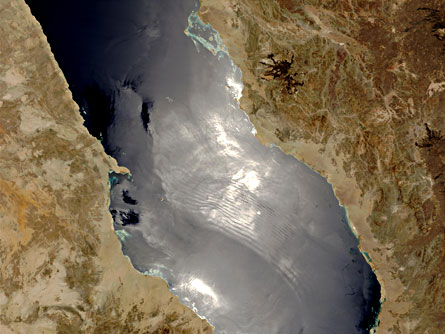- More than 2 years ago
Every day huge, underwater waves surge and ebb far outside the rims of continents. Flowing much faster than the visible tides, these “internal tides” usually don’t make it to the surface or close to the coast. But, because they move around the sediment as it collects below, these waves play big roles in shaping the edges of continental shelves.

Physicists may have now solved the riddle of the waves’ origin.
Around most coasts, relatively shallow waters cover the submerged part of each continent. Farther offshore, sediment constantly falls from the continental crust to the deeper oceanic floor. Internal tides come up at an angle that’s influenced by the physics of deep ocean water. In turn, these internal tides will shape the sediment at the edge of the crust into a continental slope of the same angle.
Internal tides may be generated by the slower ordinary tides as a resonance effect, similar to the way a repeated, gentle push can make a child sitting on a swing go higher and higher, researchers suggest in the June 20 Physical Review Letters.
“To me, it’s fascinating because it provides an explanation as to the origin of the internal waves,” comments Lincoln Pratson, a geologist at DukeUniversity in Durham, N.C.
Inside a one-meter–long pool, Hepeng Zhang and his collaborators at the University of Texas at Austin created a small-scale version of the ocean around a continent’s coastline. On one side of the tank, a slanted surface represented the continental slope.
To simulate tides, the researchers set up their miniature continental slope so they could move it in and out of the water. Although in a real tide it’s the water that moves while the coast stays still, from the point of view of the ocean’s surface, it’s as if the coast slides up and down.
The researchers also filled the tank with water that was progressively saltier — and thus denser — the deeper it got, to simulate differences in ocean water density, which changes as both salinity and temperature change.
As they created their artificial tidal waves, Zhang and his colleagues saw that a layer of water right above the continental slope started flowing as much as 10 times faster than the simulated tides. The researchers calculated that energy from the simulated tide could progressively accumulate by resonance, generating an internal wave that would oscillate between water layers of different densities.
Density differences allow waves to form, Zhang explains. For example, surf waves arise at the interface between the air and the much denser water. The same can happen at the interface between two liquids of different densities, like water and oil.
In the case of the deep ocean, however, density varies smoothly rather than abruptly, which allows waves to propagate at an angle instead of just horizontally.
However, the team only saw the resonance, and thus the internal waves, appear at a particular angle, an observation corroborated by their theoretical calculations. This would explain why continental slopes don’t get any steeper than about 3 degrees. The twice-daily shear of the internal tides keeps removing any excess sediment.
Previous research into how internal waves affect continental slopes assumed that the waves originated somewhere other than near the continental slope. “In our picture, we don’t require this external source,” Zhang says.
David Cacchione, a retired USGS oceanographer in Camas, Wash., who helped discover the internal tides’ effects on the continental slopes, says that a more accurate experiment should also include the effects of the Earth’s rotation.
Watch a simulation of underwater waves:
Picking up speed from Science News on Vimeo.
Oceanic tides create underwater waves that shape the sediment deposits off a continent’s coast. In this lab experiment, a simulated tide (upper left) generates a faster-moving wave near the surface.
Video courtesy of Zhang






